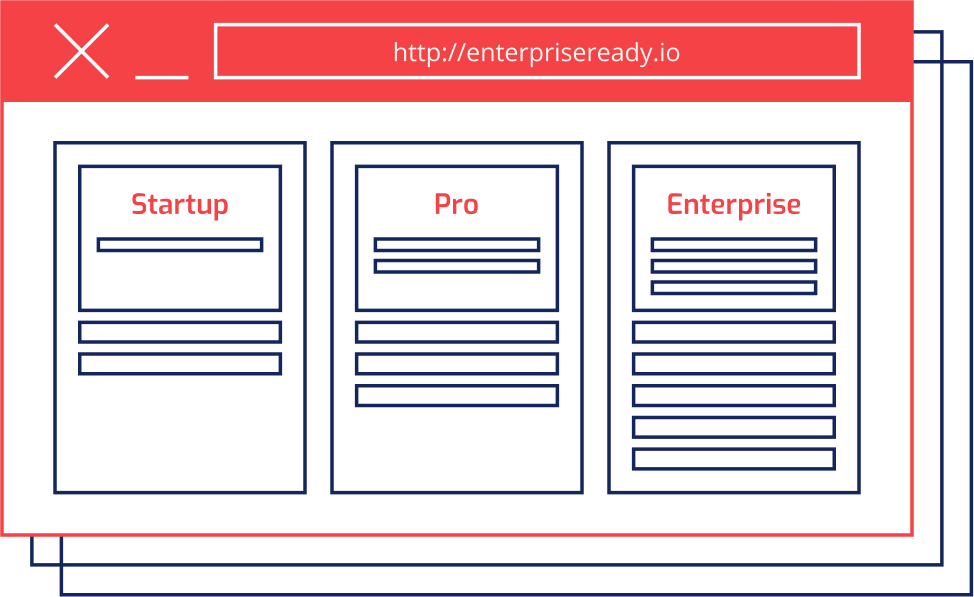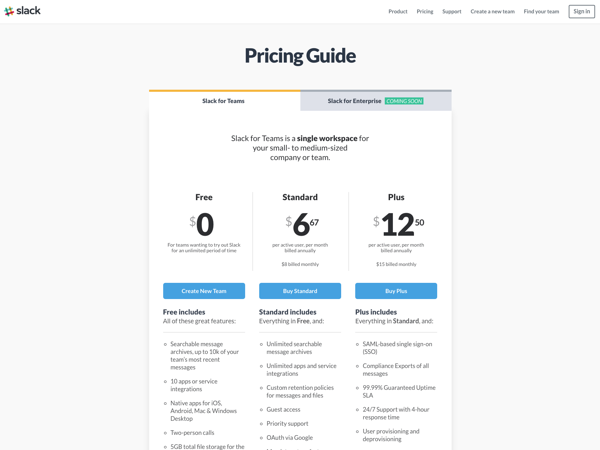
Product Assortment
Product assortment is the method by which SaaS companies create different product packages to appeal to different buyer segments. This is most evident on SaaS pricing pages where plans are listed as “Startup”, “Professional” and “Enterprise.” Often those plans differ in terms of the features offered, the level of support provided, and the price charged for the product or service.
In general, the features that differentiate the “Startup” and “Enterprise” pricing plans and create product assortment are the same features that define EnterpriseReady. Why add these features to a product? 1) Large companies require them in order to buy and use most products (allowing you to create more value for the customer). 2) Large companies are willing to pay more for a version of a product that has those features (allowing you to capture more value). 3) Enabling enterprise-focused features for all customers introduces costs and complexity for smaller customers that can reduce value created by the product and reduce value captured by the SaaS company offering the product.
Unique Requirements of “Enterprise” Buyers
Enterprises face unique problems in adopting third party SaaS applications due to their scale & risk profile. Enterprises inherently push the limits of scale and are, by definition, BIG. They have many employees, policies, customers, vendors etc. Equally important is the desire of enterprises to reduce risk around business continuity, security, compliance, availability etc. In order to adopt a third-party application, the enterprise buyer must be confident that the product can meet their requirements around scale and risk.
Product Assortment Enables Value Capture
EnterpriseReady products recognize that the needs of large organizations differ from those of individual users and smaller organizations. They also recognized that these users receive differing amounts of value from the software. Traditional ‘one-size fits all’ SaaS pricing can make it hard to capture value in proportion to the value created for larger customers. Therefore, many SaaS companies create variations of their product to appeal to each market and allow them to capture value more proportionally. In the product pricing world, this is called vertical product assortment (this talk by Michael Dearing is a great overview of pricing & product assortment). Additionally, consumer research shows that it’s important to not overload the purchaser with too many options, with three offerings being the most common number of options to aim for. Assortments are an old idea. They weren’t invented by SaaS companies. In fact you can find assortments in practically every sector of the economy going back hundreds or even thousands of years.
Simplifying the Small Customer Experience
Feature bloat can kill the simplicity and utility of SaaS products over time. Great products should be easy for new customers to get started with immediately, but have the power to satisfy the needs of advanced power users. One way to accomplish this is to only offer a subset of functionality to customers who self-select into a less complicated (and less expensive) version of the product. These starter plans can be a great way to get adoption into large customers through a grassroots or bottom-up software adoption model made popular by the likes of Yammer, Slack, GitHub, Salesforce, Dropbox and Atlassian. And the feature set, service requirements, and pricing are compatible with one another: targeted to the simpler-to-service segment of users.



